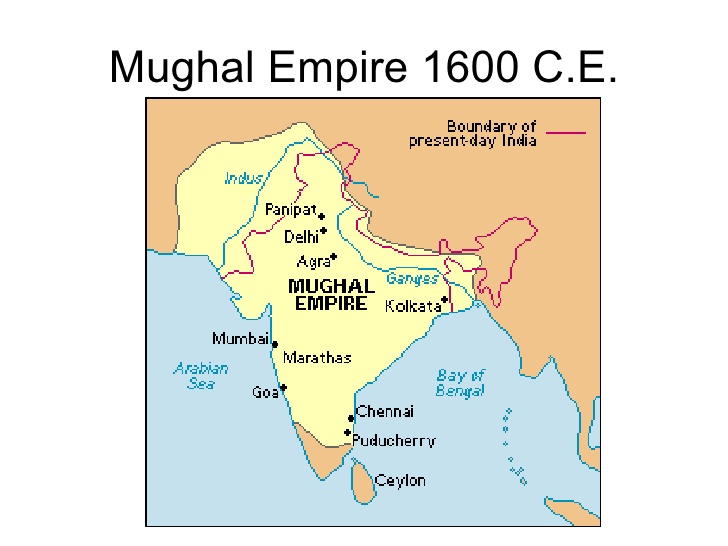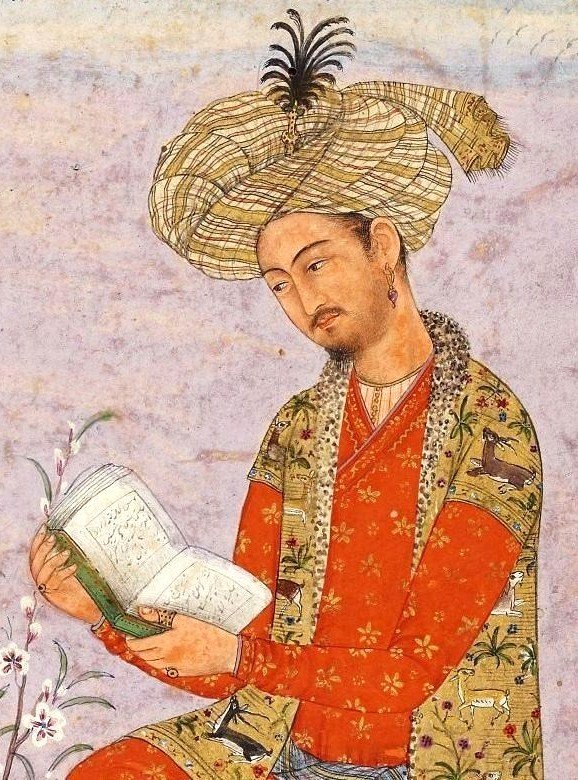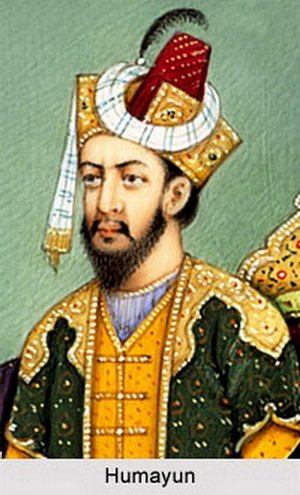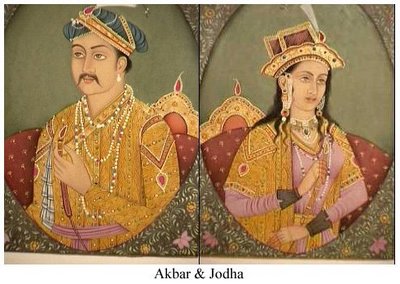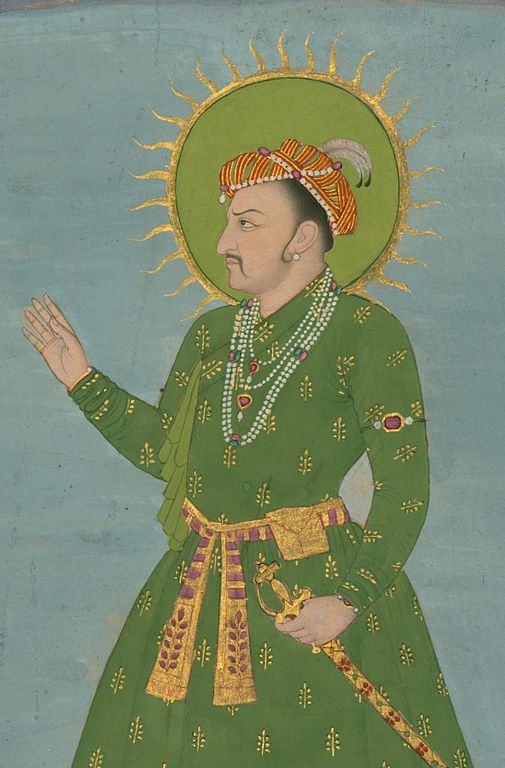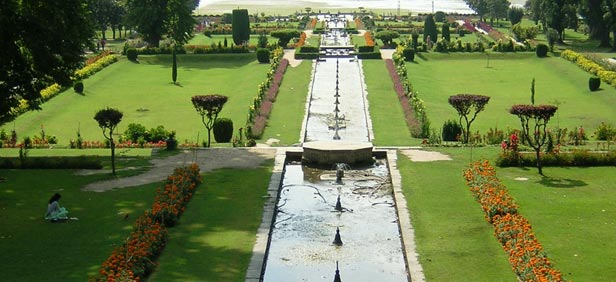- Home
- History of India
- Indian Dynasties
- Mughal Dynasty in India
Mughal dynasty in India
Quick Facts:
Dynasty: Mughal Dynasty
Country: India
Ruled From: 1526-1540,1557-1857.
Founder: Babur
Capital: Agra, Delhi, Fathepur Sikri
Religion: Sunni Islam
Important Rulers: Babur, Humayun, Akbar, Jahangir, Shah Jahan, Aurangzeb
Mughal dynasty in India was the famous dynasty which ruled India from
1526. Babur defeated Ibrahim Lodi in the battle of Panipat
and started this famous dynasty of Mughals in India. Mughal dynasty ruled India
from 1526.
Timeline of Mughal Dynasty
Name
Period of Rule
Father
Mother
Babur
1526-1530 AD
Umar Sheikh Mirza
Qutlugh Nigar Khanum
Humayun
1530-1540,1555-1556
Babur
Mahum Begum
Akbar
1556-1605
Humayun
Hamida Banu Begum
Jahangir
1605-1627
Akbar
Mariam-uz-zamani
Shah Jahan
1627-1658
Jahangir
Jagat Gosain
Aurangzeb
1658-1707
Shah Jahan
Mumtaz Mahal
Bahadur Shah
1707-1712
Aurangzeb
Nawab Bai
Jahandar Shah
1712-1713
Bahadur Shah I
Nizam Bai
Farrukhsiyar
1713-1719
Azim-usn-Shan
Sahiba Niswan
Rafi ud Darajat
1719
Rafi-ush-Shan
Razyiat-un-Nissa Begum
Shah Jahan II
1719
Rafi-ush-Shan
Nur-un-Nissa Begum
Muhammad Shah
1719-1748
Jahan Shah
Fakhr-un-Nissa Begum
Ahmad Shah Bahadur
1748-1754
Muhammad Shah
Qudsia Begum
Alamgir II
1754-1759
Jahandar Shah
Anup Bai
Shah Jahan III
1759-1760
Muhi-us-Sunnat Mirza
Rushqimi Begum
Shah Alam II
1760-1788
Alamgir II
Zinat Mahal
Mahmud Shah Bahadur
1788
Ahmad Shah Bahadur
Akbar II
1806-1837
Shah Alam II
Qudsia Begum
Bahadur Shah II
1837-1857
Akbar Shah II
Lela Banu Begum.
Mughal Administration
Mughals ruled India for a very long period. The administrative reforms that were introduced during Mughals period was further reformed and followed by British. Akbar introduced some of the great administrative reforms which helped for the further development of Mughal Dynasty in India.
Mughals followed the provincial
administrative system. The Mughals did not follow the Khalifa system for them
the king was the head of Legislative, executive, judiciary and army. The King was the head of the state. The
Emperor was considered as the highest state of authority. In case of any
discrepancies in Islamic Laws then emperor was considered as the final
arbitrator
The king was assisted by council of Ministers:
Diwan: Diwan was also known as Wazir was the second to Emperor. He
was considered as the Prime minister. He was mainly concerned with the revenue
and finance but however he could also see the work of other department. He was
assisted by ministers like Diwan-i-tan and Diwan-i-Khalsa who looked after the
salaries and state lands respectively.
The most famous finance Minister was Raja Todar Mal who worked during Akbar’s
reign. Todar Mal introduced various vast measures like introduction of standard
weights and measures, a land survey and settlement system.
Mir Bakshi:
He took care of army and also the appointment of soldiers. The head of the military was called as Mir Bakshi and was in charge of intelligence gathering.
Vakil: Another important minister in Mughal administration was
Vakil. Bairam Khan was the Vakil during Akbar period. Occasionally he was
appointed as higher authority even superior to Wazir and other ministers and
was functioning like a deputy to the emperor.
Akbar, Jahangir and Shah Jahan together had ten Vakils.
Sadr-us Sudur:
His main duty was to protect the laws of Shariat. He advised Emperor
on all religious matters. He took care of all the religious institutions, and
matters dealing with charity and other religious matters. He also advised
Emperor for appointing Sadrs and also supervised their work. Before giving
grants to any institution or for all religious places, Sadt-us Sudur
scrutinised the application before sending it to the approval of the Emperor.
Daroga-i- dak-chauki:
He was taking care of the intelligence department. He with the help of ministers under him collected information about the happenings in the state and reported it to the Emperor.
For the convenience and for better administration the Mughal Empire
had provincial administrations. Each province was known as Subahs. It is an Arabic and Persian word. It was
initiated by Akbar and in the beginning there were 12 Subahs but later the
number was increased to 15. The 12
subahs that were created during the period of Akbar are Agra Subah, Ajmer,
Awadh, Bengal, Bihar, Delhi, Gujarat, Kabul, IIIahabad, Lahore, Malwa and
Multan.
The governor who was the head was known as Subahdar. Subah were
further divided into Sarkars or District. Sarkars were further divided into
Parganas or Mahals. To improve the administrative system Akbar started with the
Provincial administration. Later as the Mughal Empire started to disintegrate
many Subahs became independent and started to rule the province or were either
conquered by Marathas or British. The number was further increased to 22 during
Shah Jahan period.
Mughal Emperors
· Babur (1526-1530)
· Humayun (1530-1540, 1555-1556)
· Akbar (1556-1605)
· Jahangir (1605-1627)
· Shah Jahan( 1628-1658)
· Aurangzeb (1658-1707)
Babur is the founder of the Mughal dynasty in India. He defeated Ibrahim Lodhi in a fierce battle of Panipat. Babur’s actual name was zahirud- din Muhammad born to parents Omar Shiekh Mirza II and Qutlugh Nigar Khanum. His father was a direct descendants of Turk-Mongal conqueror Timur from Barlas clan and his mother was a direct descendant from Genghiz Khan.
Babur was born on 14th February 1483 at a town called Andijan that is presently in Uzbekisthan. The name Babur is derived from the Persian language which means ‘Lion’. After his father’s death, Babur took over the reign of the dynasty when he was just 11 years old. A valiant warrior from the very young age, Babur soon began expanding his territory. In 1504 Babur conquered Kabul. In 1522, he conquered Khandhar. Later he turned towards India. In the year 1522 the northern part of India was ruled by Ibrahim Lodhi who was not a capable ruler. The governor of Punjab was effective noble named Daulat Khan. He with the help of Babur defeated Lodhi in a fierce battle of Panipat.
Major battles fought by Babur of Mughal dynasty
Battle of Panipat:
In 1526, Babur fought with Ibrahim Lodhi to enter India and founded Mughal dynasty in India. This is the first major battle Babur fought in India.
Battle of Khanwa:
In 1527, Rajput ruler Rana Sanga thought Babur as foreigner and decided to oust him from India. But however Rana’s plan failed and he was miserably crushed by Babur’s forces in the battle of Khanwa which strengthened Mughal foundations in India.
Battle of Ghagra:
In 1529, the combined forces of Afghan rulers of Bihar and Bengal defeated Babur in battle of Ghagra.
Babur was a great statesman and a man of solid achievement. He was also a great scholar in Arabic and Persian languages. However he was not a good administrator. He left the territory among his chiefs of military and entrusted with them work of administration. Each local ruler had his own system of administering and enjoyed the power to its full extent. Babur did not take any steps to establish a common revenue system for the whole of empire. No attempt was made to fix a uniform tax demand on the basis of actual production. Even the judicial system was not proper. Even the financial administration was pretty poor. Babur died on 26th Dec 1530.
Humayun of Mughal dynasty in India
Humayun (1530-40) (1555-56) of Mughal dynasty:
After the death of Babur, Humayun took over the Kingdom of Mughal dynasty. Babur had completely mishandled the financial administration. The empire was in dearth of money. Humayun had huge task to uplift the Mughal dynasty. His half brother Kamran Mirza was made the ruler of Kabul and Lahore. The other two brothers Hindal and Askari were weak and hence were under Humayun’s control. His cousins opposed Humayun. Instead of dealing with his enemies firmly, Humayun divided his forces, weakened them and wasted time in enjoying.
Humayun had two main rivals namely Sultan Bahadur of East and Sher Shah Suri. Humayun’s court was full of nobles who were busy plotting a coup and occupy the throne. His empire included the provinces of Balkh, Qundez, Badakhshah in Central Asia and Multan, the Punjab modern Uttar Pradesh, Bihar, Gwalior, Bayana, Chanderi in India.
In 1540, Mughal dynasty came under the control of one of the nobles. Farid Khan Sur, who assumed the regional name of Shir Shah Sur. In the battle of Bilgram the Afghan attacked the Mughal troops and Humayun failed in controlling them. Humayun fled to Agra and took shelter in Agra, but however the opponents did not show any mercy to Humayun and went to Agra. Humayun who had no choice fled to West Lahore. Even Humayun’s brother Kamran did not help him but instead supported Sher Shah Suri. This is when Sher Shah Suri started Sur dynasty. Sher Shah Suri ruled India from 1540- 45 and later died in 1545. His son was a weak ruler he too died in 1554. On seeing the opportunity to come back to India, Humayun sent his army along with Bairam Khan to Delhi. Humayun came back in 1555 to Delhi and once again started Mughal dynasty. But Humayun met with an accident in the library and died on 25th Feb 1556. He was succeeded by his son Akbar.
Some of the important battles waged by Humayun are:
Battle at Kalingar (1531): Humayun besieged the fort of Kalingar in Bundelkand after this war
Battle of Dauhariya (1532): In this Humayun defeated Mohammed Lodi.
Battle of Chausa (1539): War with Sher Shah Suri. In this Humayun was defeated.
Battle of Kannauj (1540): Again in Agra Sher Shah Suri attacked Humayun. Humayun was defeated and fled to Lahore.
Akbar-Mughal dynasty
Akbar (1556-1605) of Mughal dynasty:
Akbar, the Mughal emperor also known as Akbar the great or Jalaludin was the third emperor of Mughal dynasty. He was born on 14th October 1542 to emperor Humayun and his wife Hamida Banu Begum. He succeeded his father at a very young age of 13 years in the year 1556. Akbar was born in Sind now in Pakistan. His ancestors included both Genghiz Khan and Timur. Akbar was raised by his uncle in Afghanistan. His childhood was full of fully occupied with training on warfare and hence had no time to study. After his father’s death, Akbar took over the reins at the age of 13. As he was a minor Akbar was under able guidance by Bairam Khan.
The beginning years of his reign were very tough and difficult. He lost Delhi to Hemu but however General Bairam Khan and Khan Zaman1 defeated Hemu in second battle of Panipat and took control on Delhi, Agra and Gwalior. In 1564, Akbar attacked Godwana and captured it. At the age of 18 Akbar dismissed Bairam Khan and took complete control of the empire. Bairam Khan was asked to move to Mecca. But he became a rebellion.
Akbar was
not only aggressive but also wise statesman. For consolidation and conquests of
his empire he adopted a novel policy famously known as the Rajput policy of
Akbar. Rajput's were prestigious warrior class in the Hindu society. They were
most loyal and also very proud. Hence Akbar stressed upon establishing
matrimonial alliance with Rajput's. The rulers of Ambar, Bikaner, Jaisalmer gave
their daughters to Mughal emperor in marriage.
Administration during Akbar period
Akbar was a very good administrator. Akbar made all effort to bring order and discipline in his administration and governance. He introduced some important reforms like the famous Mansabdari System and paying his officers in cash instead of granting them Jagirs. All the powers of the empire were centralised and was headed by King with the help of council of ministers. Panchayat system was duly recognised and it looked after village affairs. Akbar was the supreme commander of the army. Special consultation with council of ministers were held at Diwan- I- Khas. Some of the council of ministers who helped were:
· Wazir (prime minister): He coordinated with work of all ministers.
· Dewan (finance minister): He looked into revenue system.
· Mir Bhakshi was the head of establishment department.
· Kham – I – Saman control of Royal guard
· Chief Qazi – Judicial department.
With the help and assistance of Raja Todar Mall, revenue system was reorganised. He fixed the revenue of the land as one third of the gross production and allowed it to be paid in kind or cash. His revenue settlements were modelled on that of Sher Shah. This bought lot of long lasting benefits to the people and government.
Akbar divided his empire into subah. In each subah,
there was a governor to take control on administration matters. Governor was
responsible for the maintenance of each subah. Each Subhas was further
classified as Sarkars. The officers in charge of Sarkar were called as
Faujidars. The military system was praise worthy.
He introduced Mansabdari system. In this there
were 33 mansabdars. The mansabdars governed the empire and commanded its armies
in the emperor’s name. Though they were usually aristocrats they did feudal
aristocracy, as neither the officers nor the estates that supported them were
hereditary. Each Mansab had to maintain a certain number of horses and troops.
These troops were used by the Mughal emperor in times of crises and wars. Some
Mansabdars commanded troops recruited not by themselves but by state. The
mansabdars system in India constituted imperial bureaucracy.
Battles during Akbar period
Second battle of Panipat in November 1556. It was with Hemu for capturing Delhi.
In 1564 war was with state of Gondwana which ruled Rani Durgavati. Akbar annexed it.
In 1581 Akbar moved his army to Kabul and defeated Mirza Hakim.
In 1586 Akbar conquered Kashmir and in 1591 he conquered Sind.
Akbar was troubled by his own sons, especially his third son Salim.
Akbar breathed his last on 12th October
1605. His body was rested into a mausoleum at Sikander city near Agra which is a
famous tourist attraction now.
Jahangir of Mughal dynasty in India
Jahangir: (1605-1627) of Mughal dynasty:
Jahangir was born in September 1569 at Fathepursikri. Jahangir was the fourth ruler of Mughal dynasty. He ruled from 1605-1627. His father was Akbar and mother was Jodha bai. He was well trained in civil and military administration. Expert tutors taught Persian, Turki, Arabic, Hindi, arithmetic to King. It is believed that Jahangir poisoned his own father, Akbar to death in 1605.
Jahangir’s own son Khusrav led a military attack but
Jahangir captured and made him blind. But Jahangir got into bad habits at a
very young age. He always feared the Persians and the Uzbeks of Central Asia.
The Persians had good military power like Mughal dynasty and were good at wars.
In 1662 taking advantage of internal problems in Mughals, the Persians attacked
and captured Kandahar.
Administration during Jahangir Period
Administration
Jahangir continued with several of his father’s policies. Like Akbar he too made a series of military campaigns and aimed at expanding Mughal rule. Jahangir tried to take control of Mewar and other states in India. He conquered Mewar, ultimately Rana the King of Mewar accepted the rule of Mughal emperor and a peace treaty was signed between the Mughals in 1615. Thus the long drawn war between Mewar and Mughals ended. It was not easy to capture Chittor. In 1608, Jahangir sent an army but later in 1615 a peace treaty was signed after which Rana Amar Singh understood the power of Jahangir and hence Mughals restored all his territory including Chittor.
Art and Culture:
Jahangir’s wife Nur Jahan was intelligent and had good interest in art. Because of her, Persian poets and artists, architects and musicians entered to Mughal court. She built a white marble tomb for her father Itimad-ud- daulah. This was built in Agra and was finished in 1628. Jahangir had fine artistic sense but he was more interested in paintings. One of the most important buildings were the completion of tomb of Akbar at Sikandra. The tomb built by Nur Jahan was highly decorated with pietra dura.
Even today it looks very grand and beautiful. Apart from building fine monuments, Mughals are also well known for grand gardens constructed during their regime. The Shalimar bagh, currently located at Srinagar, Jammu and Kashmir is built by Jahangir to please his wife is distinguished with carved pillars and surrounded by greenery. Jahangir also wrote his own autobiography titled Tuzuk- I- jahangir.
Decline of Jahangir.
Even though Jahangir was honest, he lacked the tactics like his father Akbar. Due to his bad habits Jahangir’s health deteriorated and he eventually died in 1627 while returning from Kashmir. His body was buried in Shahdara bagh in Lahore
Update on coronavirus in India
Affiliate Disclosure:
If you make any purchase via a link on this site, I may receive a small commission with no added cost to you.
